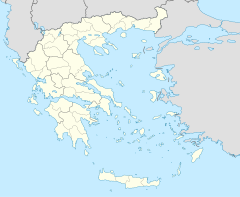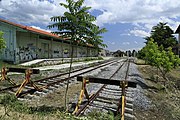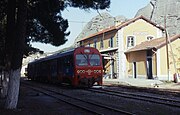Kalambaka railway station
Καλαμπάκα Kalambaka | |||||||||||||||
|---|---|---|---|---|---|---|---|---|---|---|---|---|---|---|---|
 Kalambaka station, June 2012 | |||||||||||||||
| General information | |||||||||||||||
| Location | Kalambaka 422 00, Greece Trikala Greece | ||||||||||||||
| Coordinates | 39°42′11″N 21°37′31″E / 39.7030°N 21.6254°E | ||||||||||||||
| Owned by | GAIAOSE[1] | ||||||||||||||
| Line(s) | Palaiofarsalos–Kalambaka railway[2] | ||||||||||||||
| Platforms | 2 | ||||||||||||||
| Tracks | 3 | ||||||||||||||
| Train operators | Hellenic Train | ||||||||||||||
| Construction | |||||||||||||||
| Structure type | at-grade | ||||||||||||||
| Platform levels | 1 | ||||||||||||||
| Parking | Yes | ||||||||||||||
| Bicycle facilities | No | ||||||||||||||
| Accessible | |||||||||||||||
| Other information | |||||||||||||||
| Status | Staffed | ||||||||||||||
| Website | Hellenic Railways Organisation | ||||||||||||||
| History | |||||||||||||||
| Opened | 16 June 1886[3] | ||||||||||||||
| Closed | 1998 | ||||||||||||||
| Rebuilt | 2001 | ||||||||||||||
| Electrified | No[2] | ||||||||||||||
| Services | |||||||||||||||
| |||||||||||||||
| Former service | |||||||||||||||
| |||||||||||||||
| |||||||||||||||
Kalambaka railway station line structure | |||||||||||||||||||||||||||||||||||||||||||||||||||||||||||||||||||||||||||||
|---|---|---|---|---|---|---|---|---|---|---|---|---|---|---|---|---|---|---|---|---|---|---|---|---|---|---|---|---|---|---|---|---|---|---|---|---|---|---|---|---|---|---|---|---|---|---|---|---|---|---|---|---|---|---|---|---|---|---|---|---|---|---|---|---|---|---|---|---|---|---|---|---|---|---|---|---|---|
| Diagram not to scale | |||||||||||||||||||||||||||||||||||||||||||||||||||||||||||||||||||||||||||||
| |||||||||||||||||||||||||||||||||||||||||||||||||||||||||||||||||||||||||||||
Kalambaka railway station (Greek: Σιδηροδρομικός σταθμός Καλαμπάκας, romanized: Sidirodromikós stathmós Kalambákas) is the main railway station in Kalabaka, in the Trikala regional unit, Thessaly. Opened on 16 June 1886[3] by the Thessaly Railways (now part of OSE) as its first terminal station. Today Hellenic Train operates Regional Express services to destinations across Greece. It is currently the most northwesterly part of the Greek railway network in operation.
History
[edit]The station opened on 16 June 1886 as a terminus of Thessaly Railways.[4] The original station building (and the line) was designed by the Italian Evaristo de Chirico, (father of Giorgio de Chirico). The line was authorised by the Greek government under law AMH’/22.6.1882.[5] soon after the liberation of Central Greece from the Ottomans.
After the First World War, the Greek state planned the ambitious construction of several new rail lines and links, including a standard gauge line from Kalambaka onto Kozani and then Veroia creating a conversion of the route from Volos to Kalambaka on standard gauge. In 1927, the relevant decisions were made; starting in 1928, work was carried out on the construction of the new line from Kalambaka. But a year later, it was clear that the project would exceed the estimated costs many times over. In 1932, the construction work was stopped and remains unfinished.[6] In 1955 Thessaly Railways was absorbed into Hellenic State Railways (SEK).[5]
Freight traffic declined sharply when the state-imposed monopoly of OSE for the transport of agricultural products and fertilisers ended in the early 1990s. Many small stations of the network with little passenger traffic were closed down, especially on the mainline section and between Karditsa and Kalampaka. In 2001 the section between Kalampaka and Palaiofarsalos was converted from narrow gauge (1000 mm) to standard gauge (1435 mm) and physically connected at Palaiofarsalos with the mainline from Athens to Thessaloniki.[7] Since the upgrade, travel times have improved and the unification of rail gauge allowed direct services, even InterCity services, to link Volos and Kalambaka with Athens and Thessaloniki.
In 2001 the infrastructure element of OSE was created, known as GAIAOSE. It would henceforth be responsible for the maintenance of stations, bridges and other network elements, as well as the leasing and the sale of railway assets.[1] In 2005, TrainOSE was created as a brand within OSE to concentrate on rail services and passenger interfaces. In 2009, with the Greek debt crisis unfolding OSE's Management was forced to reduce services across the network. Timetables were cut back, and routes closed as the government-run entity attempted to reduce overheads. In 2015 a 15-year-old child was airlifted to a hospital after being electrocuted at the station.[8] In 2017 OSE's passenger transport sector was privatised as TrainOSE, currently, a wholly-owned subsidiary of Ferrovie dello Stato Italiane[9] infrastructure, including stations, remained under the control of OSE. In July 2022, the station began being served by Hellenic Train, as the rebranded TranOSE.[10]
Name
[edit]In modern Greek, MP is transliterated as B, not as MB and not as MP. That shows on the station sign and also on beer labels (MPYRA).
Facilities
[edit]The station has waiting rooms on platform 1. There is a footbridge from platform 1 to platform 2, via stairs or lift. Luggage storage is no longer available; however, the station is staffed with ticket-purchasing facilities.
Services
[edit]Today, the station is served by direct lines to the rest of Greece via Palaiofarsalos, served both by intercity trains to Athens, Palaiofarsalos Larissa and Thessaloniki.[11] Previously Thessaly Railways operated a narrow gauge service to Volos.[12]
In August 2009, TrainOSE S.A. proceeded with a drastic cutback of passenger services on Thessaly lines.[13] As of spring 2020, there are ten (five in each direction) regional services on Palaiofarsalos-Kalambaka Line. In addition, there is one regional train to Athens from Kalambaka and back (884/885).
Future plans
[edit]An extension towards Ioannina and Igoumenitsa has been discussed, but a more northern line from Thessaloniki is currently the preferred trajectory of the so-called Egnatia Railway. However, as of 2020, large investments are unlikely, given the prolonged Greek government-debt crisis.
| L Ground/Concourse |
Customer service | Tickets/Exits |
| Level L1 |
Side platform, doors will open on the right | |
| Platform 1 | ||
| Platform 2 | ||
| Island platform, doors will open on the right | ||
Gallery
[edit]-
Kalambaka railway station 17 October 2011 (Ioannis Houvardas)
-
Kalambaka railway station in 1995 (The Volos–Kalambaka line was still in meter gauge at that time)
-
Kalambaka railway station, taken from just in front of the buffers at the end of line 24 May 2016
-
End of the line of the Palaiofarsalos-Kalambaka railway 24 May 2016
-
The Sign at Kalambaka railway station, still sporting the old OSE logo 2007
-
Thessaly Metre gauge system in central Greece from Volos to Kalabáka (or Kalambaka) was covered during a visit to the country in November 1992. Having spent the night here, the first move on 7 November 1992 was retracing our route as far as the junction station of Paleofarsalos. Seen here is German-built 2-car DMU no. A.6522 on train 1845, 09:40 Kalambaka to Volos. Note the rock formations in the background, which are a major tourist attraction in the area.
References
[edit]- ^ a b "Home". gaiaose.com.
- ^ a b "Annexes". Network Statement (PDF) (2023 ed.). Athens: Hellenic Railways Organization. 17 January 2023. pp. 1–2. Archived from the original on 2 October 2023. Retrieved 24 September 2023.
{{cite book}}: CS1 maint: bot: original URL status unknown (link) - ^ a b "Railway Network: Railway station Kalambaka". gaiaose.com.
- ^ "The historic Railway Station of Volos".
- ^ a b "HistoryEN | Thessaly Museum Railways". thessalyrailways.gr. Archived from the original on 2020-07-28.
- ^ Gregoriou, Alexandros C. "The Kalambaka - Kozani - Veroia railway 1928 - 1932 (Kopie im Internet Archive)". Archived from the original on April 1, 2009. Retrieved November 22, 2018.
{{cite web}}: CS1 maint: bot: original URL status unknown (link) - ^ "Upgrading of Paleofarsalos – Kalambaka line". ΕΡΓΟΣΕ. Retrieved 2019-01-03.
- ^ "Τραυματισμός Ατόμου από Ηλεκτροπληξία στο σιδηροδρομικού σταθμό Λεπτοκαρυάς Πιερίας" (in Greek). 2015-05-09.
- ^ "It's a new day for TRAINOSE as FS acquires the entirety of the company's shares". ypodomes.com. Retrieved 2017-09-14.
- ^ "TrainOSE renamed Hellenic Train, eyes expansion". 2022-07-02.
- ^ "Δρομολόγια ΤΡΑΙΝΟΣΕ".
- ^ "The Pelion Train, a mythical route". TrainOSE. Retrieved 2019-01-03.
- ^ TrainOSE S.A. "Timetables 1 August 2009", Tables 4A/B, 5A/B








